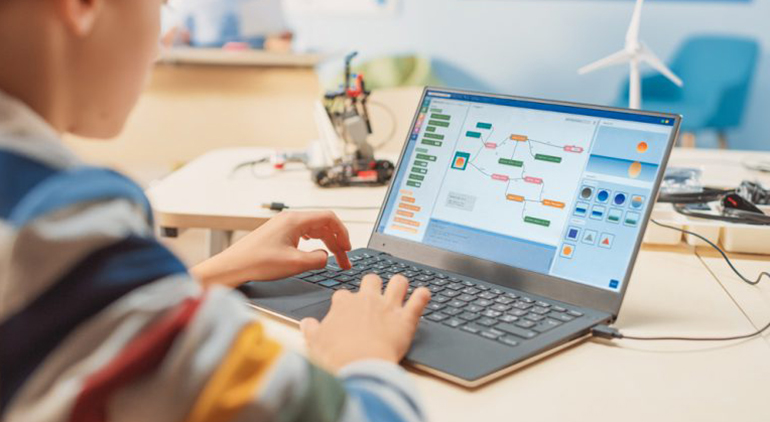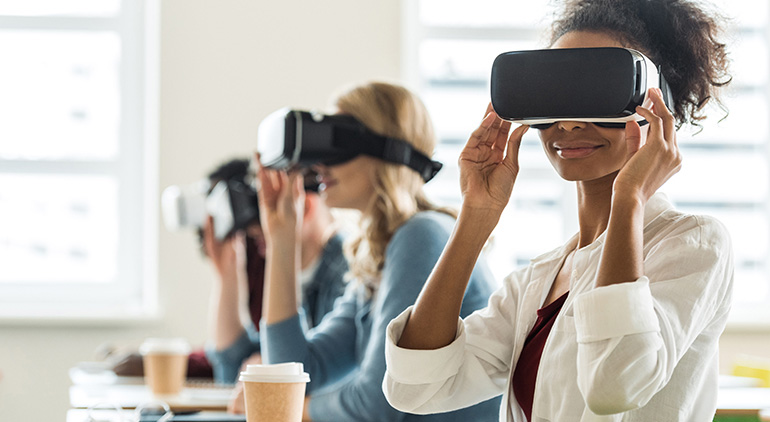How Gamification in Education Transforms Learning
The fusion of pedagogy and play is not a new phenomenon in the world of education. Many teachers and academic experts recognize the strengths of having fun and playful elements in learning and in their students’ curriculum.
However, only with gamification in education did this collective thought gain steam in the education sector.
But if you think that gamified learning or education is simply creating informative games and visuals for a subject, then you’ve glimpsed only a shade of it.
Gamification in education is a concept that is highly modular and scalable. It has all the room one would need to enhance the dynamics of traditional classrooms and learning experiences.
It aims to masterfully blend elements of what makes a game tick, so that the students learn more, and what they’ve studied, actually sticks.
This is an important facet of gamifying ordinary learning because students live in a world where they are constantly dealing with multiple sources of distraction.
And games, well, they are one of the best ways for educators to cut through all that noise and effectively communicate with the young minds in their path.
The Next Level: What is Gamification in Education?
Students today are faced with not just various sources that fill their attention span with distractions, but also with an abundance of information that achieves the same effect.
That’s why there has long been a need for learning practices and approaches in education to be able to cross these hurdles in educating young minds.
Gamification in education is one of those truly innovative approaches that has tried and succeeded in supplementing traditional education with important gaming trends.
And though we’ll soon learn most of what it entails, you should think of the approach as a process that makes attaining knowledge a purposeful and thrilling adventure.
Key Elements of Gamification in Education
Let’s take a look at some of the key elements of gamification in education that are globally transforming the learning experiences and practices of students:
✔️ Rewards System
In gamified learning, the inclusion of a reward system introduces a sense of achievement for the students, regardless of whichever subject they’re studying.
This can include components like badges for special levels and even points that can be given as rewards for various milestones like exams, quizzes, or important courses such as coding for kids.
These rewards and points have proven to be great at keeping students motivated as they progress – something to proudly show for their educational journey as well as their achievements.
✔️ Engaging Narratives
 Gamification in education is not just limited to porting over the fun and visual elements of the gaming landscape but also includes moments of creating a narrative.
Gamification in education is not just limited to porting over the fun and visual elements of the gaming landscape but also includes moments of creating a narrative.
A sense of storytelling can add a nice touch to various subjects such as history or literature, making the experience a more engaging and memorable one for the students.
Educators can choose and modulate what storytelling elements they would like for their students to see, and in this way, immerse them in narratives that lines up with their curriculum.
This instant feedback not only helps them understand from their mistake, but the fast response is useful for quickening the pace of learning. Even if it is for professional courses such as pilot training through mixed reality!
✔️ Challenges or Quests
Quests, in the context of video games, relate to certain tasks that the player must complete in the given fashion in order to move to the next step or level.
In that same vein, quests through gamification in education consist of presenting regular educational content into challenges for students to overcome, often in a similar manner.
This can include solving problems, even parts of an exam or quiz but with gamified elements to keep things light and fun.
Depending on the educators, these quests can be made to be progressively difficult or attached with rewards and other such elements.
✔️ Leaderboards
Much like in traditional video games, leaderboards are also indeed a part of gamification in education that serves a dual purpose for the students.
Since it displays how students are performing in their courses, as per their subjects and such – the constant updates serve as a handy reminder for keeping students motivated and wanting to see their ranks and points increase on the leaderboards.
Moreover, a bit of healthy competition never hurt anyone, and that is exactly what leaderboards brings to the table.
Students can see each other’s rankings and aim to one-up their friends, by performing better in the next round of quests and challenges.
✔️ Feedback
Feedback in studies or learning is an important part of the process. The results one receives after giving an exam, viewing one’s answer sheet after it has been graded, and reading the teacher’s remarks – are all examples of feedback that students have learnt to register as feedback to their efforts in the course of their studies.
Gamification in education enables ‘instant feedback’ for students as they learn on the spot about what they said or did wrong during a session.
This instant feedback not only helps them understand their mistake, but the fast response is useful for quickening the pace of learning. Even if it is for professional courses such as pilot training through mixed reality!
✔️ Immersive Technologies
 While gamifying elements of learning and educational content, educators are not just limited to the usual digital tech.
While gamifying elements of learning and educational content, educators are not just limited to the usual digital tech.
New and immersive technologies such as virtual reality headsets and augmented reality programs can bring forth a tidal wave of AR/VR in education.
These technologies allow educators to simulate real-world scenarios and even fictional elements in a much more immersive manner for their students.
And of course, it can all be customized to suit a course, giving educators and students a sense of agency over the learning journeys they want as part of their curriculum.
In this way, gamification in education has become an important segment of the educational sector.
These elements help make it suitable for various settings – ranging from classrooms to higher education facilities and even for matters like corporate or work training through gamification in the workplace.
The applications are vast and hold a lot of potential for everyone involved. But it is important to temper the amount of fun and learning with the right amount of focus on educational objectives, to gain all the benefits that it holds.
"Explore the potential of gamified experiences to revolutionize learning and captivate learners dynamically and interactively."
Decoded: Top Benefits of Gamification in Education
Because of the core elements involved in enabling gamification in education, the approach is seen as essential for achieving many educational objectives.
This relates to making the process of learning more enjoyable, and eventually increasing the amount of knowledge and skills that are retained. When implemented, it brings a range of benefits for educators as well as students.
And it also helps address the challenges traditional education faces. Here are some of the top benefits of gamification in education that are driving this change in the industry:
✔️ Increases Student Engagement
Gamification in education’s capacity to attract and maintain students' attention is one of its most significant advantages.
Even if you haven’t opted for VR classrooms, video games are intrinsically entertaining, and learners are more inclined to be excited about learning when it is given in a gamified way.
Higher rates of involvement and a more concentrated learning experience are two key results that stem from this increased engagement.
✔️ Learning Faster with Challenges
Games frequently provide problems that need critical thinking and problem-solving abilities. Gamification in education enables participants to think strategically, examine circumstances, and generate solutions by introducing these features into teaching.
They develop critical cognitive abilities as they tackle obstacles and objectives.
✔️ Fosters Collaboration and Competitiveness
The inclusion of certain elements through gamification such as leaderboards and competitive components generates a feeling of healthy competitiveness among pupils.
This competitive mentality might motivate learners to flourish better and realize their full potential.
Gamification can also incorporate collaborative aspects that encourage cooperation and peer-to-peer learning.
✔️ Long-term Retention
Gamification in education fosters long-term interest in a subject. Because they loved their experience of learning, learners will be more inclined to remember as well as use what they have learned. This enhanced retention is necessary for long-term information gain.
✔️ Invokes a Sense of Motivation
Gamified learning helps appeal to deeper drives which include fascination, competency, and a feeling of success.
Students are more encouraged to actively engage in the learning process when they receive points, badges, or awards for accomplishing assignments or understanding topics.
The sensation of accomplishment and growth becomes a tremendous motivator for continuing study.
✔️ In-built Assessment
Video games give immediate information on achievement, permitting learners to immediately understand the effects of their decisions.
This feedback loop helps students identify their strengths and shortcomings, allowing them to alter their techniques while gaining insight from their mistakes. It encourages a growth mentality and constant progress.
✔️ Customizable Learning Paths
Gamified educational systems may be customized to meet the demands and learning styles of individual students.
This customization enables learners to continue at their speed, ensuring that subjects are properly understood before moving on.
Plus, this personalized approach encourages a more in-depth comprehension of the content.
A Win for Learning: Gamification Examples in Education
The market for gamified learning and education is expected to reach around $358 billion by the year 2025. Considering the benefits that we’ve just discussed above; this comes as no surprise.
In fact, many students, actually prefer gamified learning experiences. Educators across various levels in the education sector have often reported a marked increase in student retention and productivity – somewhere in the neighborhood of 50% and above on average.
If you are interested in experiencing the benefits of gamification in education firsthand, then you can begin by taking the first step with us.
We invite you to consider partnering with our team at KOMPANIONS, where we have created numerous gamified solutions for learning and training in the industry.
Our experts can help bring exciting and innovative changes to your educational approach. Call us for a quick consultation. And let’s level up the way your students learn on this gamified adventure.







